Denim
Denim is a sturdy cotton warp-faced[1] textile in which the weft passes under two or more warp threads. This twill weaving produces a diagonal ribbing that distinguishes it from cotton duck. While a denim predecessor known as dungaree has been produced in India for hundreds of years, denim itself was first produced in the French city of Nîmes under the name serge de Nîmes.[2]
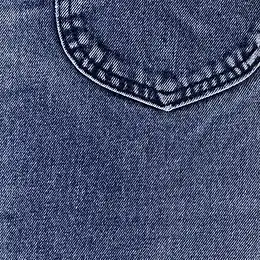
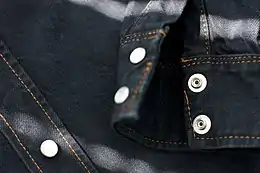
Denim is available in a range of colors, but the most common denim is indigo denim in which the warp thread is dyed while the weft thread is left white. As a result of the warp-faced twill weaving, one side of the textile is dominated by the blue warp threads and the other side is dominated by the white weft threads. Jeans fabricated from this cloth are thus predominantly white on the inside.[3]
Etymology and initial popularity
The word 'denim' derives from French serge de Nîmes 'serge from Nîmes'.[4][3]
Denim has been used in the United States since the mid-19th century.[5] Denim initially gained popularity in 1873 when Jacob W. Davis, a tailor from Nevada, manufactured the first pair of rivet-reinforced denim pants. The popularity of denim jeans outstripped the capacity of Davis's small shop, so he moved his production to the facilities of dry goods wholesaler Levi Strauss & Co., which had been supplying Davis with bolts of denim fabric.[6]
Throughout the 20th century denim was used for cheap durable uniforms like those issued to staff of the French national railways.[7] In the postwar years, Royal Air Force overalls for dirty work were named "denims". These were a one-piece garment, with long legs and sleeves, buttoned from throat to crotch, in an olive drab denim fabric.[8]
Creating denim
All denim is created through generally the same process:[9]
- Cotton fiber is spun into yarn
- Some of the yarn is dyed, some left white
- The yarns are woven on a shuttle loom or projectile loom
- The woven product is sanforized
Yarn production
Most denim yarn is composed entirely of cotton. Some denim yarn may use an elastic component such as spandex for up to 3% of the content to allow the final woven product to stretch. Even such a small amount of spandex enables a stretching capacity of about 15%.
Dyeing
Denim was originally dyed with indigo dye extracted from plants, often from the genus Indigofera. In South Asia, indigo dye was extracted from the dried and fermented leaves of Indigofera tinctoria; this is the plant that is now known as "true indigo" or "natural indigo". In Europe, use of Isatis tinctoria, or woad, can be traced back to the 8th century BC, although it was eventually replaced by Indigofera tinctoria as the superior dye product. However, most denim today is dyed with synthetic indigo dye. In all cases, the yarn undergoes a repeated sequence of dipping and oxidation — the more dips, the stronger the color of the indigo.[10]
Prior to 1915, cotton yarns were dyed using a skein dyeing process, in which individual skeins of yarn were dipped into dye baths. Rope dyeing machines were developed in 1915, and slasher or sheet dyeing machines were developed in the 1970s; both of these methods involve a series of rollers that feed continuous yarns in and out of dye vats. In rope dyeing, continuous yarns are gathered together into long ropes or groups of yarns – after these bundles are dyed, they must be re-beamed for weaving. In sheet dyeing, parallel yarns are laid out as a sheet, in the same order in which they will be woven; because of this, uneven circulation of dye in the dye bath can lead to side-to-side color variations in the woven cloth. Rope dyeing eliminates this possibility, because color variations can be evenly distributed across the warp during beaming.[10][11]
Denim fabric dyeing is divided into two categories: indigo dyeing and sulfur dyeing. Indigo dyeing produces the traditional blue color or shades similar to it. Sulfur dyeing produces specialty black colors and other colors, such as red, pink, purple, grey, rust, mustard, and green.
Weaving
.jpg.webp)
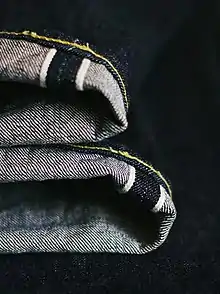
Most denim made today is made on a shuttleless loom[12] that produces bolts of fabric 60 inches or wider, but some denim is still woven on the traditional shuttle loom, which typically produces a bolt 30 inches wide. Shuttle-loom-woven denim is typically recognizable by its selvedge (or selvage), the edge of a fabric created as a continuous cross-yarn (the weft) reverses direction at the edge side of the shuttle loom. The selvedge is traditionally accentuated with warp threads of one or more contrasting colors, which can serve as an identifying mark.
Although quality denim can be made on either loom, selvedge denim has come to be associated with premium products since final production that showcases the selvedge requires greater care of assemblage.[13]
The thickness of denim can vary greatly, with a yard of fabric weighing anywhere from 9 to 32 oz,[14] with 11 to 14 oz being typical.[15]
Post-production treatment
Particularly with denim jeans, a significant amount of the aesthetic treatment of denim occurs after the denim has been cut and sewn into the final garment.
 Skinny jeans made from red denim
Skinny jeans made from red denim A miniskirt made from purple denim
A miniskirt made from purple denim Jeans made from light grey denim
Jeans made from light grey denim
Many denim articles are washed to make them softer and to reduce or minimize shrinkage even beyond what sanforization prevents. Significantly washed denim can resemble dry denim which has faded naturally over extended use. Such distressing may be supplemented by chemical treatments or physical techniques such as stone washing.
Changes in appearance due to use
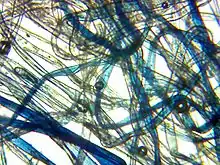
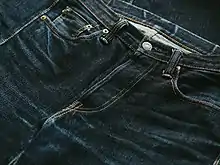
Over time dry denim will fade, considered fashionable in some circumstances. During the process of wear, fading will usually occur on those parts of the article that receive the most stress. On a pair of jeans, this includes the upper thighs, the ankles, and the areas behind the knees.[15]
To facilitate the natural distressing process, some wearers of dry denim will abstain from washing their jeans for more than six months.[16] Most dry denim is made with 100% cotton and comes from several different countries.
Patterns of fading in jeans caused by prolonged periods of wearing them without washing are a way of "personalizing" the garment.[17] Such patterns include:
- honeycombs – meshes of faded line-segments that form behind the knees[18]
- whiskers – faded streaks that form radially from the crotch area[18]
- stacks – irregular bands of fading above the ankle caused by according of the fabric due to contact with the foot or shoe[19][20]
- train tracks – fading along the out-seams due to abrasion[20]
Uses
Clothing
Furniture
Vehicles
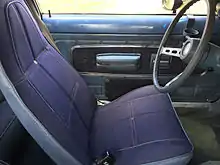
As jeans grew in popularity in the early 1970s, "one of the most creative carmakers of the era, AMC, took note."[21] Starting with the 1973 model year, American Motors (AMC) offered a regular production option consisting of a Levi's interior trim package.[22][23] American Motors had an objective of offering fashion interiors for its cars and the Levi's trim was "designed to appeal to young men and women who enjoy the casual look in clothes and cars.[24] Over the years it was available on the Gremlin, Hornet, and Pacer.
Although the car's jean material looks just like the real thing, AMC used spun nylon that was made to imitate denim. This was because real denim fabric is not tough enough for automobile use and cannot pass fire resistance safety standards.[25] The copper rivets were the actual versions and the seat design included traditional contrasting stitching with the Levi's tab on both the front seat backs. The option also included unique door panels with Levis trim and removable map pockets, as well as "Levi's" decal identification on the front fenders. The Levi's trim package option was $134.95, but only $49.95 extra if ordered together with the "Gremlin X" appearance option.[26] The Levi's interior upholstery was available through the 1978 model year AMC Gremlin.[27] It has become one of the best-known options on the Gremlins.[28]
A Levi's trim package was also available by AMC on most Jeeps, including the CJ series, the full-size Cherokee (SJ), and the J series pickup trucks from 1975 through 1977.[29] This consisted of denim-colored-and-textured vinyl upholstery and a matching canvas top.[30] This option was available on all CJ models in blue or tan, and was the standard trim on the top-level Renegade versions.[31] The Levi's association was removed in later years with the upholstery trim named "Denim vinyl" through 1980.[32]
Between 1973 and 1975 Volkswagen produced the Jeans Beetle, which had denim interior trim and special exterior graphics for sale in Europe.[33] This concept was repeated in some later models.[34]
Art
British artist Ian Berry has been making art with only denim for well over a decade.[35] and is famed around the world for his photorealistic pieces all hand cut out of only denim of portraits and scenes.[36][37] He has made pieces of Ayrton Senna,[38] Giorgio Armani,[39] Lapo Elkann,[40] Debbie Harry,[41][42][43] Jenifer Saunders, Eunice Olumbide OBE[44] among others. In 2013, he was named as one of the top 30 Artists under 30 in the World by Art Business News.[45]
Many everyday people from around the world have taken to creating art on their denim, often using fabric paint or acrylic to add a personal touch and express themselves further in their clothing.
Worldwide market

In 2007, the worldwide denim market equalled US$51.6 billion, with demand growing by 5% and supply growing by 8% annually.[46] Over 50% of denim is produced in Asia, most of it in China, India, Turkey, Pakistan, and Bangladesh.
Globally, the denim industry is expected to grow at a CAGR of over 6.5% during 2015 to 2020, with the market value expected to increase from $113 billion to $153 billion.[47]
The following table shows where the world's denim mills are located.[46]
| Region | Number of mills |
|---|---|
| China | 297 |
| India | 23 |
| Asia (excluding India and China) | 81 |
| North America | 9 |
| Europe | 41 |
| Latin America | 46 |
| Africa | 15 |
| Australia | 1 |
| Total | 513 |
See also
References
- Mogahzy, Y. E. (2009). Engineering Textiles: Integrating the Design and Manufacture of Textile Products (First ed.). Woodhead Publishing. p. 362. ISBN 978-1-84569-048-9.
- "Story of Denim Blue Jeans across the Eras" (PDF). Archived from the original (PDF) on 21 April 2018. Retrieved 21 April 2018.
- St. Clair, Kassia (2018). The Golden Thread: How Fabric Changed History. London: John Murray. p. 177. ISBN 978-1-4736-5903-2. OCLC 1057250632.
- Bellis, Mary (19 May 2014). "Levi Strauss - The History of Blue Jeans". About.com. Retrieved 25 August 2015.
"Levi Strauss had the canvas made into waist overalls. Miners liked the pants, but complained that they tended to chafe. Levi Strauss substituted a twilled cotton cloth from France called "sergé de Nimes". The fabric later became known as denim and the pants were nicknamed blue jeans". In French of Nimes or De Nimes shortened to Denim
- Hegarty, Stephanie (28 February 2012). "How jeans conquered the world". BBC News. Retrieved 25 August 2015.
- Salazar, James B. (1 June 2010). "Fashioning the historical body: the political economy of denim". Social Semiotics. 20 (3): 293–308. doi:10.1080/10350331003722851. ISSN 1035-0330. S2CID 144304564.
- https://static.cnews.fr/sites/default/files/styles/image_640_360/public/uniformes_sncf.jpg?itok\x3depxgXmHa
- Bagshaw, R.; Deacon, R.; Pollock, A.; Thomas, M. (2006). RAF Little Rissington: the Central Flying School 1946-76. Pen and Sword Books. ISBN 9781844153817.
- Chauncy, Barbara (2011). Denim by design. Krause Publications Craft. ISBN 9780896895980.
- Bojer, Thomas Stege (16 December 2016). "How Denim Is Made: Indigo Dyeing". Denimhunters. Retrieved 2 September 2019.
- Mercer, Harry (19 May 2011). "Rope Dyeing Vs Slasher (Sheet) Dyeing". Denims and Jeans. Archived from the original on 12 October 2016. Retrieved 2 September 2019 – via Archive.org.
- K W Yeung, Yan Li, L Yao (2003). The China and Hong Kong Denim Industry. p. 11.
- Shelton, Todd. "What is selvedge denim?". Retrieved 2 February 2016.
- heavydenimkings (17 April 2019). "The Last 32oz Release from Naked and Famous Denim". HDK. Retrieved 5 June 2020.
- Shuck, David (12 September 2011). "The Essential Raw Denim Breakdown – Our 100th Article!". Heddels.com. Retrieved 25 August 2015.
...a pair of raw denim is like an individualized canvass. Indeed the fade results and any other visible marks, rips, or tears are specific you and your body ...
- Slater, Sean (25 January 2012). "When Should I Wash My Raw Jeans? – A Rough Guide". Heddels.com. Retrieved 25 August 2015.
- Goh, Yang-Yi (12 September 2011). "Denim Dialogues, Vol. II: Making Them Your Own". Handlebar Magazine. Archived from the original on 27 June 2015. Retrieved 25 August 2015.
- Coe, Nick (11 May 2011). "Fade Types – Whiskers/Hige & Honeycombs". Heddels. Retrieved 12 June 2017.
- Coe, Nick (17 May 2017). "How do you get fades near the leg openings of raw denim jeans?". Heddels. Retrieved 1 April 2019.
- Shapira, J.A. (14 December 2016). "The Denim Jeans Guide — Gentleman's Gazette". www.gentlemansgazette.com. Retrieved 23 November 2018.
- "Even AMC cars were hit by the blue jeans craze of the 1970s". MeTV. 16 August 2017. Retrieved 30 September 2019.
- Lamm, Michael (October 1972). "AMC: Hornet hatchback leads the lineup". Popular Mechanics. 138 (4): 118–119. Retrieved 21 August 2015.
- "1973 AMC Full Line brochure". oldcarbrochures.org. pp. 6–8.
- Strohl, Daniel (30 June 2007). "American Flava: the Levi's Gremlin press release". Hemmings. Retrieved 30 September 2019.
- Stopford, William (27 September 2015). "Top 10 Obscure Special Editions and Forgotten Limited-Run Models: AMC Edition". Curb side classic. Retrieved 30 September 2019.
- "1974 AMC Gremlin X Levi's Edition". Just a Car Geek. 13 April 2011. Retrieved 30 September 2019.
- "1978 AMC Full Line Brochure". oldcarbrochures.org. p. 22. Retrieved 30 September 2019.
- Koscs, Jim (19 February 2019). "The much-maligned AMC Gremlin is gaining legitimacy as a collector car". Hagerty. Retrieved 30 September 2019.
- "1977 Jeep Full Line brochure". oldcarbrochures.org. p. 28. Retrieved 30 September 2019.
- Statham, Steve (2002). Jeep Color History. MBI Publishing. pp. 101–102. ISBN 9780760306369. Retrieved 30 September 2019.
AMC offered an optional Levis package in 1975 CJ denim-like vinyl and matching canvas top.
- Foster, Patrick R. (2014). Jeep: The History of America's Greatest Vehicle. Motorbooks. p. 104. ISBN 9781627882187. Retrieved 21 August 2015.
- Statham, Steve (2002). Jeep Color History. MBI Publishing. p. 100. ISBN 9780760306369. Retrieved 30 September 2019.
AMC Levis interior.
- Torchinsky, Jason (20 May 2013). "A Pantload Of Jeans-Themed Cars On The Anniversary Of Levi's Patent". Jalopnik. Retrieved 30 September 2019.
- "Chronology and Descriptions". Jeansbeetles.com. Retrieved 21 August 2015.
- "About". IAN BERRY. Retrieved 29 June 2018.
- "Artist creates works in denim". BBC News. 23 May 2018. Retrieved 29 June 2018.
- "Printed Press". IAN BERRY. Retrieved 29 June 2018.
- "Ayrton Senna Portrait by Ian Berry | Ayrton Senna - Legacy Matters". www.ayrton-senna-dasilva.com. 8 June 2015. Retrieved 29 June 2018.
- "Giorgio Armani". IAN BERRY. Retrieved 29 June 2018.
- Rathe, Adam. "They've Been Framed: Celebrity Portraits". DuJour. Retrieved 29 June 2018.
- Atkinson, Neil (28 May 2014). "Huddersfield artist Ian Berry provides denim tribute to 70s star Debbie Harry". huddersfieldexaminer. Retrieved 29 June 2018.
- "Debbie Harry denim portrait commissioned for Ray-Ban". ilovejeans.com. 22 May 2014. Retrieved 29 June 2018.
- Gonsalves, Rebecca (6 July 2014). "Frames of mind: Ray-Ban adds new twist to classic sunglasses". The Independent. Retrieved 29 June 2018.
- "'Switch' Exhibition in collaboration with The Olumide Gallery, London". Getty Images. Retrieved 29 June 2018.
- Tedesco, Ashley (20 November 2013). "Denimu's 'A Blue Eye'". Art Business News. Retrieved 29 June 2018.
- Agarwal, Sandeep (13 October 2009). "World Denim Market – A Report on Capacities, Market Size, Forecasts etc". Denimsandjeans.com. Retrieved 25 August 2015.
- The Textile Magazine (17 October 2016). "An overview of the Global and Indian Denim Market". www.indiantextilemagazine.in. Retrieved 5 May 2017.
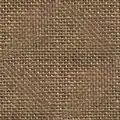
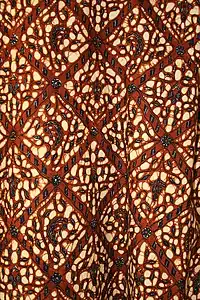
.svg.png.webp)